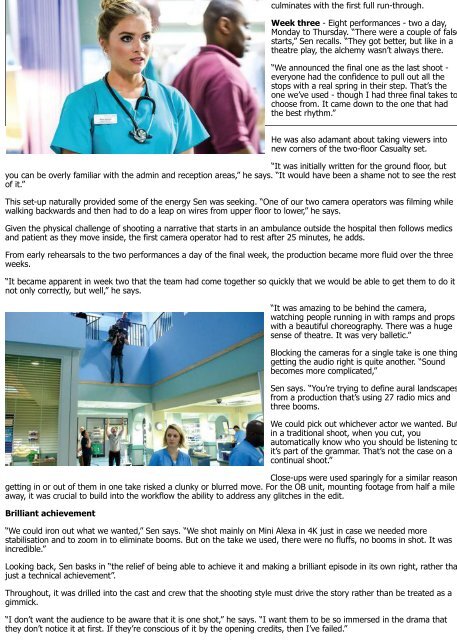Casualty, BBC1 | In-depth | Broadcast
You also want an ePaper? Increase the reach of your titles
YUMPU automatically turns print PDFs into web optimized ePapers that Google loves.
culminates with the first full run-through.<br />
Week three - Eight performances - two a day,<br />
Monday to Thursday. “There were a couple of false<br />
starts,” Sen recalls. “They got better, but like in a<br />
theatre play, the alchemy wasn’t always there.<br />
“We announced the final one as the last shoot -<br />
everyone had the confidence to pull out all the<br />
stops with a real spring in their step. That’s the<br />
one we’ve used - though I had three final takes to<br />
choose from. It came down to the one that had<br />
the best rhythm.”<br />
He was also adamant about taking viewers into<br />
new corners of the two-floor <strong>Casualty</strong> set.<br />
“It was initially written for the ground floor, but<br />
you can be overly familiar with the admin and reception areas,” he says. “It would have been a shame not to see the rest<br />
of it.”<br />
This set-up naturally provided some of the energy Sen was seeking. “One of our two camera operators was filming while<br />
walking backwards and then had to do a leap on wires from upper floor to lower,” he says.<br />
Given the physical challenge of shooting a narrative that starts in an ambulance outside the hospital then follows medics<br />
and patient as they move inside, the first camera operator had to rest after 25 minutes, he adds.<br />
From early rehearsals to the two performances a day of the final week, the production became more fluid over the three<br />
weeks.<br />
“It became apparent in week two that the team had come together so quickly that we would be able to get them to do it<br />
not only correctly, but well,” he says.<br />
“It was amazing to be behind the camera,<br />
watching people running in with ramps and props<br />
with a beautiful choreography. There was a huge<br />
sense of theatre. It was very balletic.”<br />
Blocking the cameras for a single take is one thing<br />
getting the audio right is quite another. “Sound<br />
becomes more complicated,”<br />
Sen says. “You’re trying to define aural landscapes<br />
from a production that’s using 27 radio mics and<br />
three booms.<br />
We could pick out whichever actor we wanted. But<br />
in a traditional shoot, when you cut, you<br />
automatically know who you should be listening to<br />
it’s part of the grammar. That’s not the case on a<br />
continual shoot.”<br />
Close-ups were used sparingly for a similar reason<br />
getting in or out of them in one take risked a clunky or blurred move. For the OB unit, mounting footage from half a mile<br />
away, it was crucial to build into the workflow the ability to address any glitches in the edit.<br />
Brilliant achievement<br />
“We could iron out what we wanted,” Sen says. “We shot mainly on Mini Alexa in 4K just in case we needed more<br />
stabilisation and to zoom in to eliminate booms. But on the take we used, there were no fluffs, no booms in shot. It was<br />
incredible.”<br />
Looking back, Sen basks in “the relief of being able to achieve it and making a brilliant episode in its own right, rather tha<br />
just a technical achievement”.<br />
Throughout, it was drilled into the cast and crew that the shooting style must drive the story rather than be treated as a<br />
gimmick.<br />
“I don’t want the audience to be aware that it is one shot,” he says. “I want them to be so immersed in the drama that<br />
they don’t notice it at first. If they’re conscious of it by the opening credits, then I’ve failed.”


